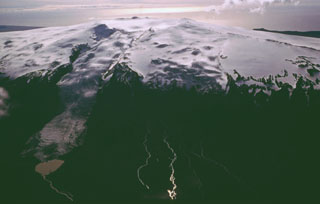Report on Eyjafjallajokull (Iceland) — 5 May-11 May 2010
Smithsonian Institution / US Geological Survey
Weekly Volcanic Activity Report, 5 May-11 May 2010
Managing Editor: Sally Sennert.
Please cite this report as:
Global Volcanism Program, 2010. Report on Eyjafjallajokull (Iceland) (Sennert, S, ed.). Weekly Volcanic Activity Report, 5 May-11 May 2010. Smithsonian Institution and US Geological Survey.
Eyjafjallajokull
Iceland
63.633°N, 19.633°W; summit elev. 1651 m
All times are local (unless otherwise noted)
The Institute of Earth Sciences at the Nordic Volcanological Center (NVC) reported that during 5-11 May the eruption from Eyjafjallajökull continued to produce ash plumes from the summit vent. Based on analyses of imagery from weather satellites, scientific overflights, and pilot reports, ash plumes ranging in color from light gray to black rose to altitudes of 4-9 km (13,100-29,500 ft) a.s.l. and drifted ESE, SE, and S. The cinder cone in the summit crater continued to build and was near the level of the ice on the crater rim on 8 May.
On 5 and 6 May explosive activity increased and effusive activity decreased, resulting in higher eruption plumes and increased tephra fallout. The lava flow stopped advancing, and very little steam rose from the edges of the flow. Ashfall was reported in areas 55-70 km away during 5-8 May, and was "considerable" on 6 and 7 May. Ash was reported in a few areas within 12 km E and SSE during 9-10 May. According to new articles, ash plumes again caused flight disruptions during 5-11 May in several European countries, including Scotland, Ireland, Spain, and Portugal.
Geological Summary. Eyjafjallajökull (also known as Eyjafjöll) is located west of Katla volcano. It consists of an elongated ice-covered stratovolcano with a 2.5-km-wide summit caldera. Fissure-fed lava flows occur on both the E and W flanks, but are more prominent on the western side. Although the volcano has erupted during historical time, it has been less active than other volcanoes of Iceland's eastern volcanic zone, and relatively few Holocene lava flows are known. An intrusion beneath the S flank from July-December 1999 was accompanied by increased seismic activity. The last historical activity prior to an eruption in 2010 produced intermediate-to-silicic tephra from the central caldera during December 1821 to January 1823.
Sources: Agence France-Presse (AFP), Institute of Earth Sciences, Reuters

